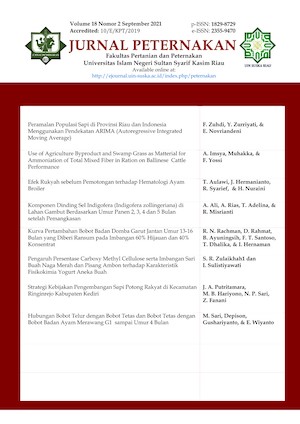Peramalan Populasi Sapi di Provinsi Riau dan Indonesia Menggunakan Pendekatan ARIMA (Autoregressive Integrated Moving Average)
DOI:
https://doi.org/10.24014/jupet.v18i2.11558Keywords:
ARIMA, impor, peramalan, populasi sapi, provinsi riauAbstract
ABSTRAK. Sejak beberapa tahun terakhir, Indonesia selalu melakukan impor daging sapi dari luar negeri untuk memenuhi kebutuhan dalam negeri. Hal tersebut dikarenakan stok daging nasional hanya mampu memenuhi permintaan dalam negeri sebanyak 45-70 persen sejak tahun 2018. Salah satu upaya peningkatan produksi daging sapi dapat dilakukan dengan cara melakukan upaya peningkatan populasi sapi dan salah satunya adalah dengan melakukan Program Integrasi Sawit-Sapi. Sebagai provinsi yang memiliki luas areal sawit terbesar di Indonesia, Provinsi Riau menjadi provinsi yang dapat dijadikan percontohan pengembangan program ini sehingga perlu diadakan analisis lebih lanjut untuk mencari target potensial peningkatan populasi sapi yang bisa dicapai di Provinsi Riau dalam lima tahun ke depan (2021-2025). Analisis dengan menggunakan metode ARIMA digunakan untuk memproyeksikan populasi sapi di Provinsi Riau dan populasi nasional dalam jangka waktu tersebut. Hasil analisis menunjukkan bahwa proyeksi peningkatan populasi sapi di Provinsi Riau hanya sebesar 0,13 persen dan memiliki potensi peningkatan hingga 5,22 persen. Sementara itu, dalam kurun waktu yang sama, peningkatan populasi sapi nasional sebesar 1,87 persen dengan potensi maksimal hingga 3,74 persen. Berdasarkan hal tersebut, peningkatan populasi sapi di Provinsi Riau dengan mengaplikasikan Program Integrasi Sawit-Sapi layak untuk dilakukan karena memiliki potensi peningkatan yang lebih besar dibandingkan potensi peningkatan populasi sapi secara nasional.
The Forecasting of Cow Population in Riau Province with Autoregressive Integrated Moving Average Approach
ABSTRACT. Since the last few years, Indonesia always imported beef from abroad to meet domestic needs. This is because the national meat stock is only able to meet 45-70 percent of domestic demand since 2018. One of the efforts to increase beef production can be done by making efforts to increase the population of cattle and one of them is by implementing the Oil-Cattle Integration Program. As a province that has the largest oil palm area in Indonesia, Riau Province has become a pilot province for the development of this program. So further analysis is needed to find potential targets to increasing cattle population that can be achieved in Riau Province in the next five years (2021-2025). Analysis using the ARIMA method is used to predict the cattle population in Riau Province and the national population in time. The results of the analysis show that the forecast of increase in cattle population in Riau Province is only 0.13 percent and has maximum potential up to 5.22 percent. Meanwhile, during the same period, the forecast of increase in the national cattle population was 1.87 percent with a maximum potential up to 3.74 percent. Based on the calculation, increasing the cattle population in Riau Province by applying the Oil Palm-Cattle Integration Program is feasible because it has the potential for an increase which is greater than the potential for increasing the population of cattle nationally.
References
Agus, A., & Widi, T. S. M. 2018. Current situation and future prospects for beef production in Thailand - A review. Asian-Australasian Journal of Animal Sciences. 31(7): 968–975.
Badan Pusat Statistik. 2019. Distribusi Perdagangan Komoditas Daging Sapi di Indonesia 2019. Badan Pusat Statistik.
Badan Pusat Statistik. 2020a. Impor Daging Sejenis Lembu menurut Negara Asal Utama, 2010-2019. Ekspor-Impor Badan Pusat Statistik.
Badan Pusat Statistik. 2020b. Produksi Daging Sapi menurut Provinsi. Badan Pusat Statistik.
Badan Pusat Statistik. 2020c. Statistik Indonesia 2020 Statistical Yearbook of Indonesia 2020. Statistical Yearbook of Indonesia. April, 192.
Bangun, R. H. B. 2017. Penerapan Autoregressive Integrated Moving Average (ARIMA) pada Peramalan Produksi Kedelai di Sumatera Utara. Jurnal Agrica. 9(2):90.
Benda-Prokeinová, R., & Hanová, M. 2016. Consumer’s behavior of the foodstuff consumption in Slovakia. Procedia - Social and Behavioral Sciences. 220 (March), 21–29.
Direktorat Jenderal Perkebunan. 2019. Statistik perkebunan Indonesia 2018-2020. Buku Statistik Perkebunan Indonesia. p1–82.
Hanurowati, N., & Prahutama, A. 2016. Pemodelan dan Peramalan Indeks Harga Saham Gabungan (IHSG), Jakarta Islamic Index (JII), dan Harga Minyak Dunia Brent Crude Oil menggunakan Metode Vector Autoregressive Exogenous (VARX). Jurnal Gaussian. 5(4): 683–693.
Kementerian Pertanian. 2020. Populasi Sapi Potong Provinsi Riau. Didownload di: https://aplikasi2.pertanian.go.id/bdsp/id/komoditas.
Maulana, H. A. 2018. Pemodelan Deret Waktu dan Peramalan Curah Hujan pada Dua Belas Stasiun di Bogor. Jurnal Matematika Statistika dan Komputasi. 15(1):50.
Rusdiana, S., & Soeharsono, N. 2018. Program Siwab untuk meningkatkan populasi sapi potong dan nilai ekonomi usaha ternak. Forum Penelitian Agro Ekonomi. 35(2):125.
Sena, D., & Nagwani, N. K. 2015. Application of Time Series Based Prediction Model to Forecast per Capita Disposable Income. Souvenir of the 2015 IEEE International Advance Computing Conference, IACC 2015. 3:454–457.
Widiati, R. 2014. Membangun industri peternakan sapi potong rakyat dalam mendukung kecukupan daging sapi. Wartazoa. 24(4): 191–200.
Yamin, M., Muhakka, & Abrar, A. 2010. Kelayakan Sistem Integrasi Sapi dengan Perkebunan Kelapa Sawit di Provinsi Sumatera Selatan. Jurnal Pembangunan Manusia. 10(1):1–21.
Downloads
Published
Issue
Section
License
The Authors submitting a manuscript do so on the understanding that if accepted for publication, copyright of the article shall be assigned to Jurnal Peternakan and published by Fakultas Pertanian dan Peternakan Universitas Islam Negeri Sultan Syarif Kasim Riau as publisher of the journal.
Authors who publish with this journal agree to the following terms:
Authors automatically transfer the copyright to the journal and grant the journal right of first publication with the work simultaneously licensed under a Creative Commons (CC BY) that allows others to share the work with an acknowledgement of the work's authorship and initial publication in this journal.
Authors are able to enter into separate permission for non-exclusive distribution of the journal's published version of the work (e.g., post it to an institutional repository or publish it in a book), with an acknowledgement of its initial publication in this journal.
Authors are permitted and encouraged to post their work online (e.g., in institutional repositories or on their website) prior to and during the submission process, as it can lead to productive exchanges, as well as earlier and greater citation of published work (See The Effect of Open Access).

